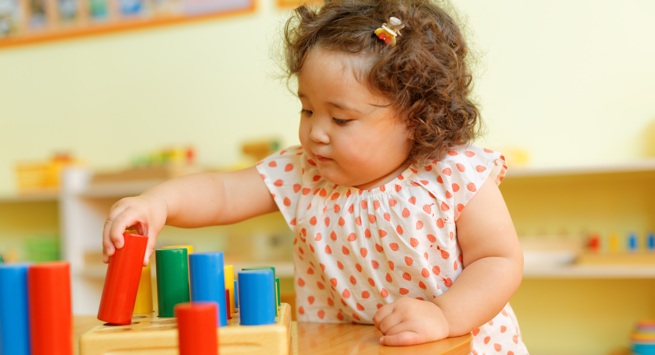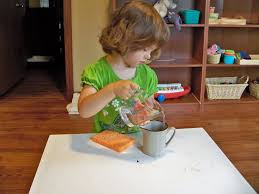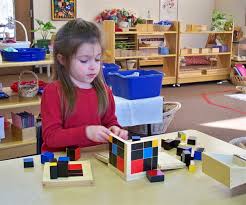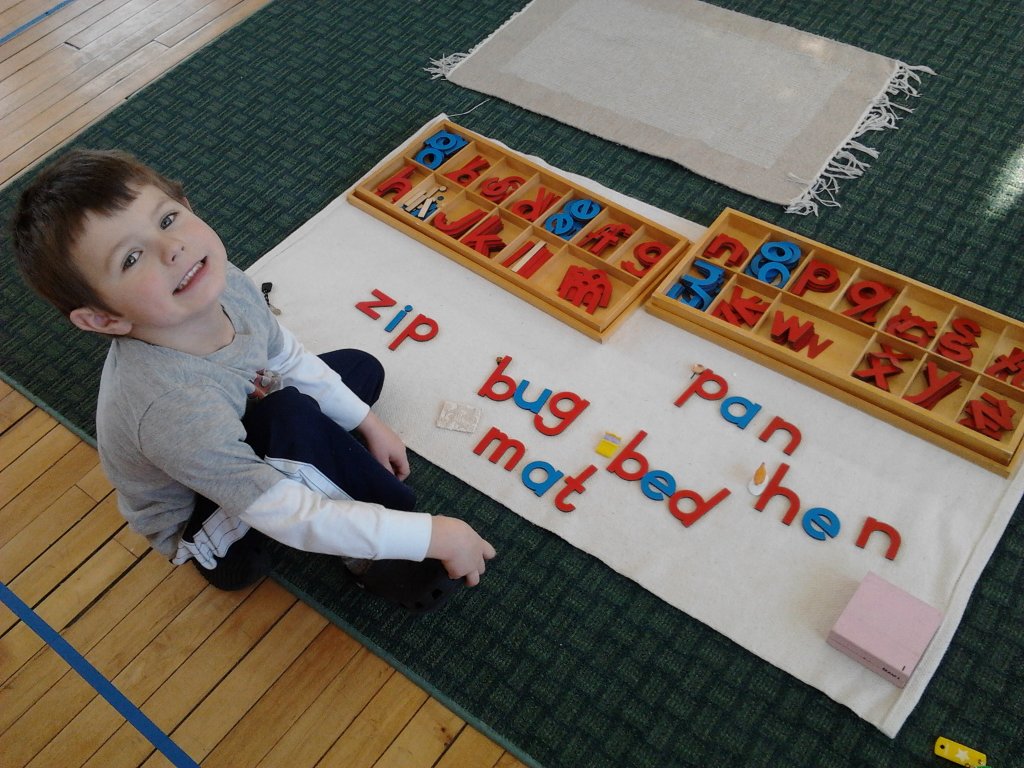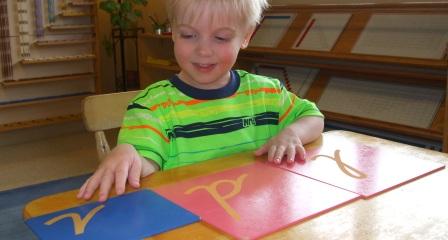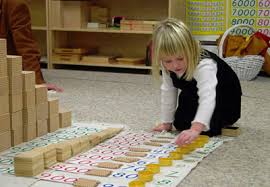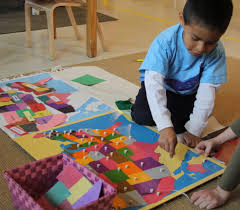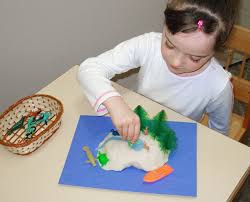Montessori Activities in Montessori Education
The Montessori Classroom is based on well researched and proven techniques formulated by Dr. Maria Montessori. Through her research she established that “The most important period of life is not the age of university studies, but the first one, the period from birth to age six.”In the Montessori classroom the children work independently at their own pace. While in the Montessori classroom environment, where there are independent choices, the child stimulates his/her own natural instincts and interests for self-directed learning. The child becomes interested and self-motivated to work cooperatively, become responsible and independent, gain effective communication and leadership skills and appreciate diversity. Dr. Maria Montessori developed a well founded program for the education of the young child which include the five major areas as follows:
Practical Life Activites
Practical: means basic, useful, purposeful
Life: means the way of living.
Practical life Exercises are just that, they are Exercises so the child can learn how to do living activities in a purposeful way.
Meaning and Purpose of Practical Life
The purpose and aim of Practical Life is to help the child gain control in the coordination of his movement, and help the child to gain independence and adapt to his society. Practical Life Exercises also aid the growth and development of the child’s mental power and concentration and will in turn also help the child develop an orderly way of thinking.
Exercise Groups
Practical Life Exercises can be categorized into four different groups:
1. Preliminary Applications
2. Applied Applications
3. Grace and Courtesy
4. Control of Movement.
Sensorial Activities
What is Sensorial Work
Sensorial comes from the words sense or senses. Dr. Maria Montessori introduced a subject called ‘Sensorial’ where the materials are specially designed to enable the children to use their senses to explore different attributes of the world.
All the sensorial materials involve followings:
1. Shape
2. Color
3.Texture
4.Sound
5. Smell
6. Taste
7.Temperature
8.Weight and
9.Size.
The Purpose of Sensorial Work
Montessori believed that sensorial experiences began at birth. Through his senses, the child studies his environment. Through this study, the child then begins to understand his environment.
Through work with the sensorial materials, the child is given the keys to classifying the things around him, which leads to the child making his own experiences in his environment.
Exercise Groups
Sensorial Exercises were designed by Montessori to cover every quality that can be perceived by the senses such as size, shape, composition, texture, loudness or softness, matching, weight, temperature, etc. Because the Exercises cover such a wide range of senses, Montessori categorized the Exercises into eight different groups:
Visual : able to be seen by the eye
Tactile :the sense of touch or contact
Baric : sense to the weight or pressure
Thermic: caused by heat or temperature
Auditory: to the sense of hearing
Olfactory: The sense of smell.
Gustatory: the sensation that results when taste buds in the tongue and throat Stereognostic:The Stereognostic sense allows the child to discriminate size and shape through the use of touch.
In the Visual Sense Exercises, the child learns how to visually discriminate differences between similar objects and differing objects.
In the Tactile Sense Exercises, the child learns through his sense of touch. “Although the sense of touch is spread throughout the surface of the body, the Exercises given to the children are limited to the tips of the fingers, and particularly, to those of the right hand
In the Baric sense Exercises, the child learns to feel the difference of pressure or weight of different objects. This sense is heightened through the use of a blindfold or of closing your eyes.
In the Thermic Sense Exercises, the child works to refine his sense of temperature.
In the Auditory Sense Exercises, the child discriminates between different sounds. In doing these different Exercises, the child will refine and make him more sensitive to the sounds in his environment.
In the Olfactory and Gustatory Sense Exercises, the child is given a key to his smelling and tasting sense. Although not all smells or tastes are given to the child in these Exercises, the child does work to distinguish one smell from another or one taste from another. He can then take these senses, and apply them to other smells or tastes in his environment.
In the Stereognostic Sense Exercises, the child learns to feel objects and make recognitions based on what he feels. “When the hand and arm are moved about an object, an impression of movement is added to that touch. Such an impression is attributed to a special, sixth sense, which is called a muscular sense, and which permits many impressions to be stored in a “muscular memory”, which recalls movements that have been made.
Language Activities
Introduction to Language
Language can be defined as, ‘a system of communication consisting of sounds, words and grammar, or the system of communication used by the people of a particular country or profession’
Language is a set of abstract symbols which the group, through convention, uses to indicate a particular idea. It can take many forms, oral, written, signed, symbolic (e.g. + for First Aid) and through gesture. We also use language internally to hold abstract ideas in the mind. In order to acquire language exposure to a group of able users is necessary.
Language has two components, vocabulary and syntax
• Vocabulary – words become linked to their meanings by associations in the brain
• Syntax – gives the relationship between words to create meaningful phrases and sentences
Spoken language connects a limited number of sounds, there are around 44 phonemes in English Language, the exact number depends on the speakers accent, in a systematic order to create infinite meanings.
In Montessori Languages activities are divided into following groups:
1. Language
Oral language exercises Enrichment of Vocabulary Language Training 2. Written Language
Written language exercises Graphic Symbols and their Key Sounds Sound Games Sandpaper Letters Moveable Alphabet Metal Insets 3. Handwriting
Introduction Preparations Chalkboards Sorting Symbols Writing on Paper Upper and lower case letters Capital letters, Periods, Commas and Questions Marks Transcription Spelling Scripts 4. Reading
Introduction Phonetic Object Box Phonogram Object Box Activity Words Puzzle Words 1 Little Booklets Reading Folders Phonogram Dictionary Puzzle Words 2 Reading Classification 5. Total Reading
Introduction Function of Words The Article The Adjective Logical Adjective Game Detective Adjective Game The Conjunction The Preposition The Verb The Adverb Logical Adverb Game Aspects of the Verb Continuation of Commands 6. Reading Analysis
Introduction Simple Sentence Stage 1 Simple Sentence Stage 2 Word Study
Mathematics Activities
Introduction to Mathematics
Montessori took this idea that the human has a mathematical mind from the French philosopher Pascal. Maria Montessori said that a mathematical mind was “a sort of mind which is built up with exactity.” The mathematical mind tends to estimate, needs to quantify, to see identity, similarity, difference, and patterns, to make order and sequence and to control error.
The child observes and experiences the world sensorial. From this experience the child abstracts concepts and qualities of the things in the environment. These concepts allow the child to create mental order. The child establishes a mental map, which supports adaptation to the environment and the changes which may occur in it.
In math the first group is
1. Numbers through Ten:
The experiences in this group are sequential. When the child has a full understanding of numbers through ten, the second group, 2. The Decimal System:
In decimal system focus on the hierarchy of the decimal system and how the system functions. It also starts the child on the Exercises of simple computations, which are the operations of arithmetic. The third group will be started when the decimal system is well underway. This third group,
3. Linear and Skip Counting:
The fourth group is 4. Tables of Arithmetic The fifth group is
5. The Passage to Abstraction The sixth group is
6. Fractions:
Cultural Activities
Through Monthly Unit Studies, taught in a “traditional structured group setting”, your child will be introduced to the study of Science, History, Geography, Art, and Music. Each month your child’s classroom will Explore, Discover, and Learn about different Unit Studies, such as: Life Cycles, Plant Life, our World, the Solar System, the Five Food Groups, our Five Senses, Dental Hygiene, the Heart, Cultural Traditions, celebration of Holidays, and many more!
